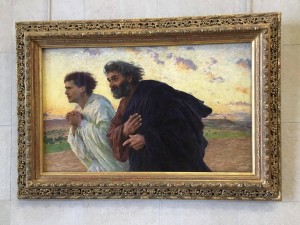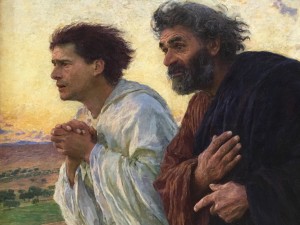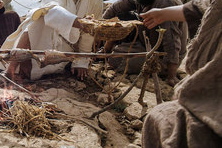
Photo: Mary van Balen
This year, the Thursday before Easter, Holy Thursday, began for me in quiet prayer with a Zoom group and continued with what became the deeper prayer of the day. I sat in my chair by the window, reading Mary Oliver and feeling my face warmed by the intense morning sun. Bright light flooding through the mini-blinds played across the book’s pages and my hands.
My cobalt glass vases glimmered on the buffet, painting the shells around them with bits of luminous blue – an altar bathed in glory of Creator and creation. As Oliver writes in her poem “On Meditating, Sort Of,” while some find times of meditation in prescribed practices and postures, she often found hers lounging against a tree.
Surely, Mary Oliver had her practices – writing itself can be a demanding spiritual practice! – Attentiveness was one. Notebook in hand, she greeted each day, noticing the world around her. Being present. That’s how the day began for me.
Holy Thursday, or Maundy Thursday as it is known in some religious traditions, has always been my favorite of the Triduum: Holy Thursday, Good Friday, and Holy Saturday. It’s the intimacy of a meal shared with family and friends. (Can you doubt that his mother and others in addition to the twelve apostles, including women, were there?) It’s the hope and prayer for unity and the example of self-sacrificing love.
John’s gospel doesn’t put the sharing of bread and wine center stage but rather Jesus’s washing his followers’ feet and the long discourse and prayer that follow. “I give you a new commandment,” he says. “Love one another as I have loved you.” And he showed them how it looked in real life that evening and the following day.


Years ago, a dear friend invited me and a few other women into her home to celebrate Holy Thursday with a simple meal before the parish services would begin. Unknown to us, she invited her guests to acknowledge their service to the community, to God’s people – what Jesus modeled at the Last Supper. When her intention became clear, I was a bit embarrassed. What had I done to be recognized by this amazing woman who has personified service her entire life?
She went around the table: one had been a lifelong educator, the first Black principal in the diocesan school system. One, volunteer director of religious education for her poor parish for close to twenty years, had just returned from leading a diverse group of teenagers to a youth convention out of state. When she got to me, our friend pointed out my decades of writing books, columns, and articles.
We enjoyed a meal and conversation. We broke bread and shared a cup of wine. We passed a pitcher of water and a bowl around the table, washing one another’s hands. We prayed. A community of women, following as best we could Jesus’s new commandments: to love and to serve.
People must not only hear about the kingdom of God but must see it in actual operation, on a small scale perhaps, but a real demonstration nevertheless.
Pandita Ramabai
This past celebration came to mind when I virtually attended a simple Holy Thursday liturgy with members of a nearby Episcopalian church. Mike Gecan, friend of the rector, longtime community organizer, and author joined us from New York to offer a meditation.
As I often do – whether pre-pandemic, physically in a church, or currently in Zoom services – when moved by a phrase or thought, I pulled out my notebook and jotted down a few things:
- Beyond reenactment
- Not simply a memorial
- A call to action
- How do we imagine what comes next, after the reenactment, after the memorial, after one action is completed?
As the night ended, these questions lingered along with images of Jesus on his knees, towel in hand, washing dirty feet, or standing on his own, imploring those gathered with him to serve others with humility. To love one another as he loves them. To become one as he and the One who sent him were one. And praying for the Grace he knew they would need – that we need today – to follow his lead.
These words, these images, follow me into Easter Week – these days of celebrating the Resurrection and the promise that Love, not death, will have the last word.
I remember the Servant-God who makes this promise and invites us to participate the transformation of death into life, here and now.
© 2021 Mary van Balen







 I saw snowdrops today, spread with abandon across a friend’s yard. Flowers! Spring, rumored to be coming soon, is on the way. After this relentless winter, flowers atop green stems are a welcome sight. Forsythia has not yet bloomed, so, according to my grandmother, we have at least three more snows to go, but I don’t mind. Today’s snowdrops were a seal on the promise of warmer days ahead. “Have a little faith,” they seemed to say. “Remember other years. Spring always comes.”
I saw snowdrops today, spread with abandon across a friend’s yard. Flowers! Spring, rumored to be coming soon, is on the way. After this relentless winter, flowers atop green stems are a welcome sight. Forsythia has not yet bloomed, so, according to my grandmother, we have at least three more snows to go, but I don’t mind. Today’s snowdrops were a seal on the promise of warmer days ahead. “Have a little faith,” they seemed to say. “Remember other years. Spring always comes.”